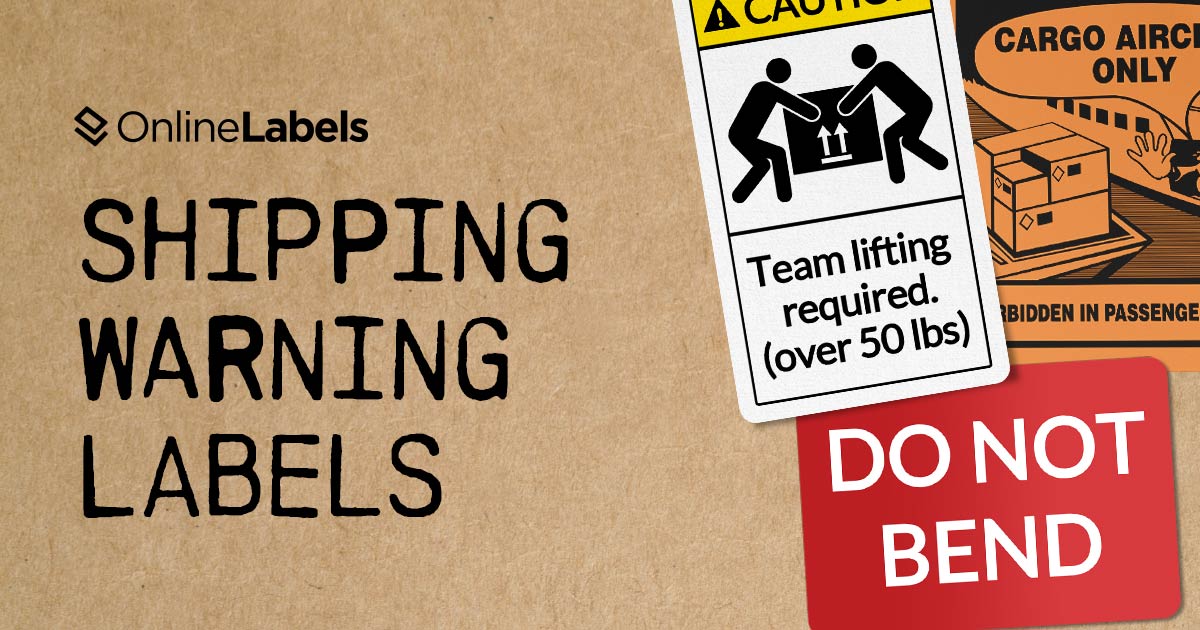The Insider’s Guide to Shipping Warning Labels

A simple label can speak volumes about safety.
From transportation by aircraft to domestic delivery, shipping warning labels play an important role in protecting not only the content of packages, but carriers and recipients as well. In this article, we’ll review the importance of warning labels in the shipping industry, including their purpose, different types, and when to implement them.
What are Shipping Warning Labels
Shipping warning labels are informative tags that alert individuals of the risks and precautions associated with a particular package. Unlike conventional labels, they showcase important safety information and guidance to ensure that individuals are aware of any potential dangers. These labels employ a combination of symbols, text, and colors to effectively serve as visual instructors on how to handle the product and how it should be delivered and addressed upon arrival.
Products that Require Shipping Warning Labels
Shipping warning labels are necessary when shipping dangerous or delicate materials that may pose a potential risk during transportation. According to the United States Postal Services portal, any mail piece containing delicate or hazardous materials must display shipping warning labels and markings at all times.
Some examples of applicable materials that may require shipping warning labels include:
- Glass
- Batteries
- Technology screens
- Ceramics
- Porcelain
- Paper
Types of Shipping Warning Labels
Shipping warning labels come in different types depending on the quality and size of the product. Some of the categories include:
- Handle with care labels outline how a user should handle a product that’s fragile or delicate, normally used for items like glass, electronics, furniture, etc.
- Do not use blades to open labels outline how a user should handle a product that’s fragile or delicate, normally used for items like glass, electronics, furniture, etc.
- This side-up fragile labels explains that a package should be kept in an upright position during transportation. This applies to products such as liquids that could spill, ceramics, television screens, etc.
- Keep dry labels indicate that a package should be protected from moisture or water. It is used with items that are sensitive to water such as paper products, or perishable goods.
- Do not stack labels emphasize how certain packages can’t handle the weight on top without getting crushed or damaged. Items that apply would be delicate machinery, glassware, etc.
- Team lifts labels applied when a package requires multiple people to lift it safely due to its weight or size. This includes hefty equipment, large boxes, or big furniture.
- Do not bend labels indicate carriers and recipients to avoid bending a package because of its structure. It can be applied to large prints, blueprints, and posters.
- Fragile labels communicate that the interiors of a package contain delicate, easily breakable content and should be addressed with care. This would include electronic devices, crystals, glassware, etc.
- Forbidden for transport labels demonstrate that the package contains items or materials that are hazardous and are not available to travel. For example, shipments that include lithium-metal batteries must have this label on a visible side.
- Perishable labels point out that products inside are likely to rot, decay, or spoil if not handled correctly in time. This must be applied to items with a limited shelf time such as flowers, pharmaceuticals, water products, etc.
- Cargo aircraft only labels indicate that an item is permitted on cargo aircraft but is too hazardous for passenger aircraft. Hazmat products and chemicals must contain these labels before traveling.
- Class 9 dangerous goods labels underline the presence of Class 9 hazardous materials that are dangerous during mobilization. Flammable solids and corrosive substances form part of this group and require this label.
- Battery UN labels provide specific information about the battery of a device, including its voltage and manufacturer information. The lithium-ion batteries of categories 3480, 3090, and 3091 must contain this label.
How to Properly Use Shipping Warning Labels
According to the United States Postal Services portal, shipping warning labels must be placed next to the designated address of the receiver. Only in extreme circumstances where there’s no space can the label be placed on the side. They must also be readily visible, with dark ink, and printed on the background with a contrasting color that makes it visible and legible.
Safety in Every Step
Remember! The correct use of labels can mark the difference between a smooth operation and a potential hazard. Shipping warning labels play a crucial role in protecting the consumer and the carrier by providing information for the transportation and handling of a product. Going over the different types of labels plays a vital role in enhancing security and promoting a safe delivery.
OnlineLabels to the Rescue
Don’t know where to start?
OnlineLabels has a variety of options on shipping warning labels to help businesses succeed in using adequate security labels. Each label is designed with clarity and high durability, ensuring that important preventive messages are communicated. Check out our other articles on battery warning labels and the best shipping label materials and take a look at how we achieve safe shipping practices!



